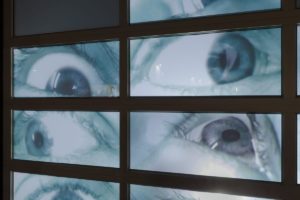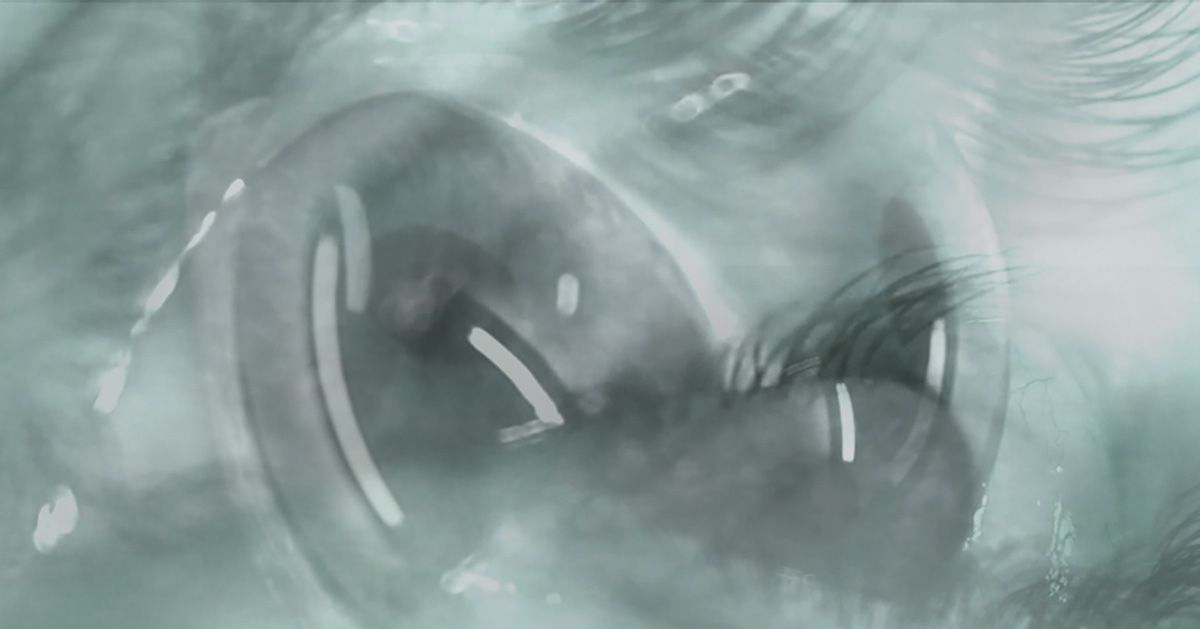Between Lorne and Scotia on E 1st Ave, the Burrard Arts Foundation (BAF) has its Garage — a literal garage door where local emerging artists are invited to display work, often concurrent with BAF Gallery exhibitions. Until March 19, /ˈsent(ə)nəl/ will be gazing out their windows.
In this multimedia piece by Eric Tkaczyk, the windows of BAF’s door are illuminated 24/7 by intermittent, glitchy videos of eyes that seem to be pressed up against the panes of glass. They wheel and dart around their little confines, frantic and isolated. While the panes slot neatly together in space, the eyes projected onto them seem unable to interact with each other. In the day, sunlight softens the videos’ intensity, making them more tempered. But at night, without the sun’s mediation, the white eyes roll around in sharp contrast to the grid separating them and the softer yellow light of the streetlamps nearby.

As articulated in the White Pube’s The Problem with Tiny Galleries, the issue with window galleries — besides compromising to landlord pressures to increase the commercial value of their properties by signaling its ‘creative uses’ — is that window shows can feel undimensional; the viewer’s ability to connect with the show is impeded by the works inaccessibility. A piece can feel more like a novelty of the window than an artwork in its own right. Impressively, Tkaczyk’s /ˈsent(ə)nəl/ rises above this almost definitive trap. The work is not only enhanced by its display format, but also — what I believe to be the strongest feature a piece can have in relation to its surroundings — is inevitable to it.
/ˈsent(ə)nəl/ explores the friction Tkaczyk feels in digital spaces’ capacity for scrutiny versus connection. It uses the viewer’s necessary distance — being partitioned from, neither in nor outside, the display-space — to that end. The artist has taken the structured format of a garage door and inlaid it with tension, toggling not only inside and outside, but also a ‘looking’ and ‘looked at.’ Closeness and distance. Real and unreal. While you the viewer can step back or stand closer, the eyes themselves can only jump across their flat screen; despite their frenicity they’re limited to two dimensions, and despite being incredibly active, they’re ostensibly immobile. They seem to look at you without registration, preoccupied with their desperation. But even that preoccupation is seeming, because of course, this piece sees nothing. It’s just light on glass. While the work is active and charged, you are the only real agent. But it’s difficult to remember that reality because of the piece’s impressive physicality. The garage door is tall and imposing, and the eyes, filmed incredibly closely, occupy the whole of their screens. The piece is made up of slated contradictions intimating the artist’s own confusions.
Alongside the digital’s scrutiny and connection, Tkaczyk hopes /ˈsent(ə)nəl/ expresses his contention with “an internet that simultaneously opens up [his] world and alienates [him.]” But in viewing the piece, while I can feel a pulsing resistance to this alienation, I don’t get that feeling of having been “opened up”. To me, that sensation is expansive — it’s wonder at the amazing breadth of everything. /ˈsent(ə)nəl/ feels cramped: the eyes are frantic, caught and pressed up against panes of glass; the crux of the piece is containment. Maybe there is a yearning for the potential to be opened up, but I don’t see it having happened yet. Even in the day, when the piece feels softer, I get an impression of these feelings being smothered in an excess of stimulation. The sunlight and the projector’s light are competing for the viewer’s eyes, and sensation is averaged out from a yell to a hum. The feeling itself doesn’t change — only its intensity.
Tkaczyk has addressed the balances of online-existence throughout his practice. His 2020 video piece /ˈtrəʊdʒ(ə)n hɔːs/ (the phonetical spelling of Trojan horse) contemplates the distortion of the body in digital spaces. In it, discrete videos of body parts forming an amalgamated body move in front of a black background — the body’s proportions exaggerating as the piece progresses. To me, this piece more steadily walks the blade between fear and possibility than /ˈsent(ə)nəl/, and its success lies in its exaggeration. The body’s morphisms are scarily, but also sillily, grotesque; Tkaczyk is opened up by humor.

/ˈsent(ə)nəl/ is an interesting addition to Tkaczyk’s oeuvre because where it would seem to fall
short, namely in its lack of attested joy, I see it as a testament to the ‘Art Practice.’ Making art is nonlinear — and the sticky syrup draping over an array of ideas is inconsistent. The allowance of an artist to suck on an idea, roll it over with their tongue, and the freedom to describe the flavor as it’s mulled, is what makes those ideas, and the art that expresses them, dimensional. The same way fermentation is inconsistent, different sites in the same system bubbling at separate rates, Tkacyzk’s feelings are allowed to flux.
Art isn’t a temporally static or timeless category. The idea that an art piece can be outside of time rests so often on colonialist assumptions and values. An artwork can’t be isolated from the time, place, and people that produced it, and that environment doesn’t stop existing or changing after the piece is made. Art practice gives each piece a micro-historicity, you get to see a catalog of the process of an idea shifting, you get to see that ideas do shift, they’re allowed to shift, and, to me, that’s the freedom of art. It’s the excitement of the project of practice.
To put the pressure to express the entirety of those ideas, or the entirety of the possibilities of those ideas, into one piece is constricting. What an overwhelming and impossible task, to have to be completely and encompassingly whole all the time. What makes an art practice a project is its freedom to be open-ended. There’s no goal, there’s no ultimate end. It is undetermined and chameleon. Like /ˈsent(ə)nəl/’s eyes, bursting in their restrictions and confines — a work can shove against the expectation of complete decipherability. Which is what /ˈsent(ə)nəl/ does so well: Tkacyzk takes this necessarily constraining thing, a tiny gallery, and uses the points where it rams into logistical limitations as the points where he confronts digital legibility.
/ˈsent(ə)nəl/’s chafing at restriction, while not an opening agent, is itself open because as restrictions placed on the art process, opportunities to develop and change, and possibilities for shift become starchier, those points of friction, those chapped, chafed points, indicate where we can loosen our grip.


